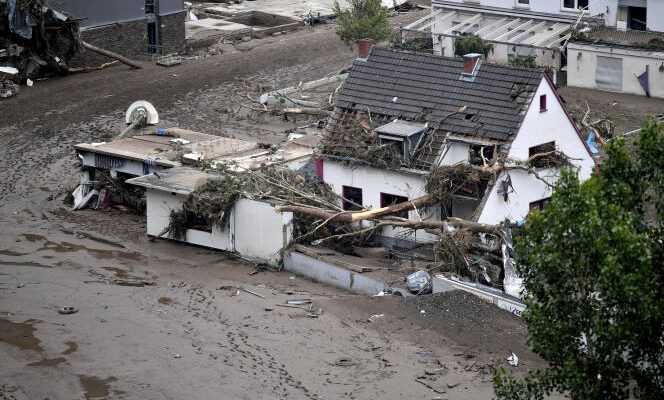The toll of devastating weather in Germany worsened further on Saturday, July 17, reaching at least 133 deaths in the country, bringing the number of victims in Europe to 157. This assessment remains provisional, because dozens of people are still missing in Germany and Belgium, where 24 dead have been counted. These rare-scale floods caused by torrential rains also caused damage in Luxembourg, as well as in the Netherlands and Switzerland.
In the region of Rhineland-Palatinate (western Germany), one of the most affected, “90 people lost their lives during the disaster”, according to the Koblenz police, which also records “Around 618 injured”. This toll comes on top of the 43 deaths in North Rhine-Westphalia, another German region hit by the disaster. “It is to be feared that we will not discover more deaths”, have warned local authorities.
Near Cologne, in Erftstadt, a portion of the village literally collapsed on itself on Friday following a huge landslide. The spectacular images of the disaster area showed a vast yawning crater into which masses of earth, brown water and debris were pouring out. “We have to assume that we will find other victims”, predicted Carolin Weitzl, mayor of Erfstadt. The head of state, Frank-Walter Steinmeier, has planned to visit this devastated town on Saturday.
Germany faced, between July 14 and July 15, torrential rains of unprecedented violence, which caused sudden floods invading inhabited areas and destroying many localities. The inhabitants who were able to take shelter Wednesday evening, when the floods started, are gradually returning to their homes. Scenes of desolation await them: destroyed houses, torn trees, overturned cars, collapsed roads and bridges, cut networks.
A colossal work of clearing
In the affected localities, firefighters, civil protection, municipal and military officials have begun the colossal work of clearing and cleaning up the piles of muddy debris which often obstruct the streets. Local media on Saturday broadcast images of military tanks on the roads of the stricken town of Erftstadt. In North Rhine-Westphalia, 19,000 rescuers were mobilized.
“The task is immense”, recognized the mayor of Solingen, a town in the south of the Ruhr area. We have to pump water, assess the solidity of damaged buildings, some of which will have to be demolished, restore electricity, gas, telephones, and house the people who have lost everything. The disruption of communication networks, which makes many people unreachable, complicates any quantification of the number of missing.
The authorities remain on the alert. In the Heinsberg district of North Rhine-Westphalia, a dam on the Rour River, a tributary of the Meuse, broke on Friday evening, leading to the evacuation of 700 people.
The government has let it be known that it is working to set up a special aid fund, when the damage is expected to reach several billion euros. Solidarity is also being organized, with appeals for donations launched throughout the country, local collections, financial support promised by large companies, such as the car manufacturer Volkswagen.
The damage is “So important that they will keep us busy for a long time”, warned the leader of Rhineland-Palatinate, Malu Dreyer, while her counterpart from North Rhine-Westphalia, Armin Laschet, spoke of a “Catastrophe of historic magnitude”.
Bad weather has placed the issue of climate change at the center of the electoral campaign, which is in full swing in Germany ahead of the legislative elections on September 26, after which Angela Merkel will step down. Leader of the conservative CDU party and favorite in the polls, Armin Laschet demanded, like the entire political class, “To pick up the pace” in the fight against climate change.
National day of mourning in Belgium
In the Netherlands, where the floods caused a lot of destruction, but no casualties, the Prime Minister, Mark Rutte, also blamed climate change, believing that the bad weather was. ” without a doubt ” a consequence. To prevent such a scenario from repeating itself, “The first thing to do, and fortunately we are doing it in the Netherlands, is to give space to the rivers”, he stressed. But the Dutch will also have to ” learn “, and ask yourself: “What more can we do? “, said Mr. Rutte.
Neighboring Belgium is also paying a heavy price, with at least 24 dead, according to a still provisional assessment. As the water recedes, “We will probably still find catastrophic situations”, ruled the mayor of Liège, Christine Defraigne. The Belgian crisis center, which centralizes data at the national level, no longer communicates about the number of missing, a spokesperson told AFP. He underlined the difficulty of reaching people due to power cuts and disruptions affecting telephone networks.
The army was deployed in four of the ten provinces of the country to take part in the relief efforts, and in particular in the numerous evacuations. “It could be that these floods are the most catastrophic that our country has ever known”, said Prime Minister Alexander De Croo, declaring Tuesday a day of national mourning. Mr De Croo and the President of the European Commission, Ursula von der Leyen, went to Rochefort on Saturday morning, one of the Belgian municipalities hit by the disaster.
The weather has improved across the country with the end of precipitation on Friday, the appearance of the sun and the arrival of summer temperatures on Saturday. As a result, the level of the streams receded, revealing a desolate landscape. Some 120 municipalities have been affected across the country. In the disaster areas, mainly in the south and east of the country, police officers were mobilized to knock on the doors of homes, in order to look for possible new victims.
